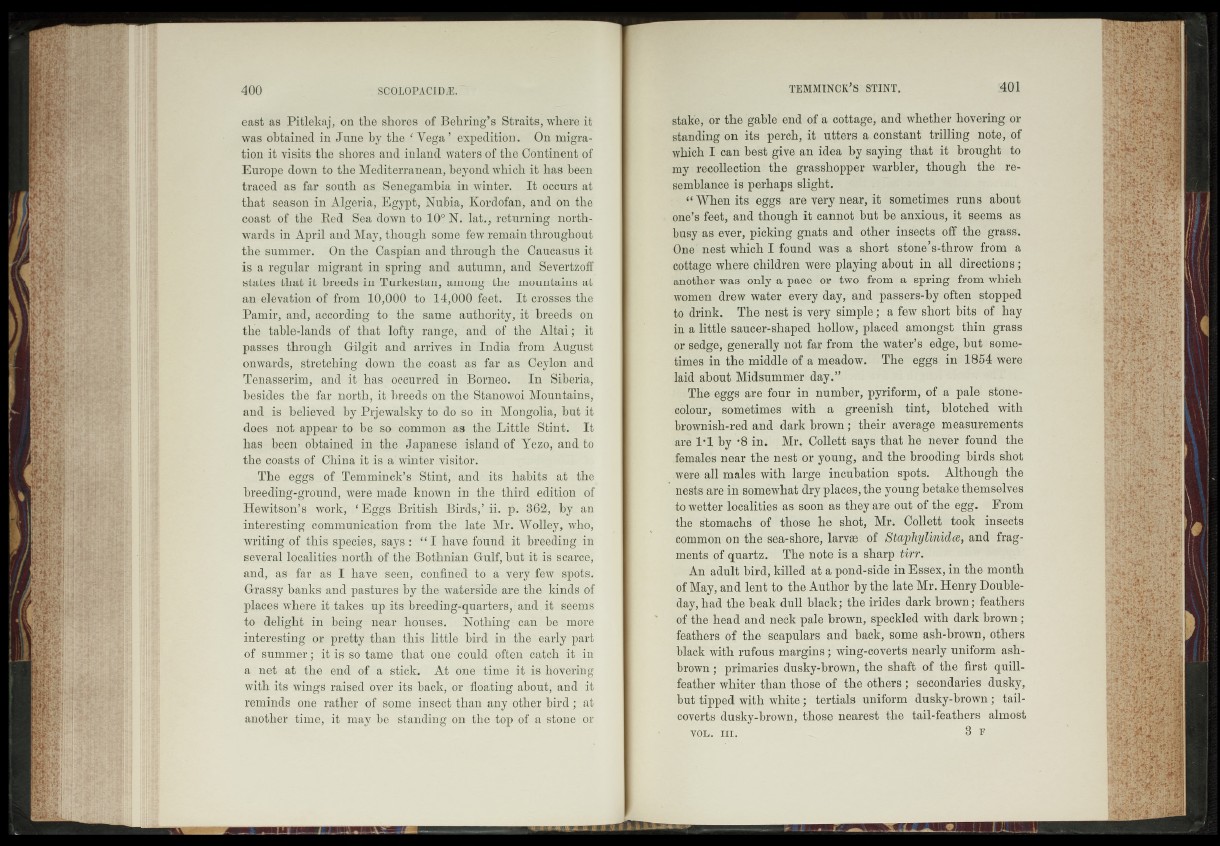
east as Pitlekaj, on the shores of Behring’s Straits, whose it
was obtained in Juno by the i Yega ’ expedition. On migration
it visits the shores and inland watersuf the Continent of
Europe down to the Mediterranean, beyond which it has been
traced as far south as Senegambia in .winter. It occurs at
that season in' Algeria, Egypt, Nubia, Kordofan, and bn‘ the
coast of the Red Sea down to 10° N,.- :lat., returning- -northwards
in April and May, though some'few remain-throughout
the summer. On the Caspian and through the Caucasus it
is . a regular migrant in spring and autumn, and ,-Severtzoff
states that it breeds in Turkestan, among the1; mountains at
an-elevation of from 10,000 to 14,000 feet. It crosses the
Pamir, and, according/to- the same authority;*it 1 breeds on
the table-lands of that lofty 'range,,-and of i the'Altai ; I t
passes through Grilgit and '/arrives lln .Tndia-Ifrom August
onwards, Stretching down the coast as far aa iCeylon- and
Tenasserim, and it has occurred in' Borneo. | In Siberia,
besides the far north, Ife-breederon d&e Stan-ow-oi Mountains,
and is. believed by Prjewalsky todo^OKin Mongolia, but it
does not appear to be so common as ithe'jLitjtSorStafiti/, It
has been obtained in the' Japanese islandSpfWezo, and to
the coasts of China it Is a winter visitor.
The eggs .of Temminck^sStint,". and llslfhabits -\at the
breeding-ground^--were made, known in the'third edition p
Hewitson’s work, f E^gs -British Birds,’ ii. p-. 36i,hyi. an
interesting communication,,from ,the, late Mr.
writing -of this species,, Says : Iff,»'have founds# hreedingShn
Several localities north of the'*Bothnian 6rulf, buk'it.ds^S'caSr.ce,
and, arS^ far1 alf-1 have.wen^conS'n-ed^ ^ai.sK^ryifew^s^hts.
. Classy banks an-d pasturesabyi th,e.®ater£id<e are the kinds if
places where it takes up its breeding/quarters, and itdiiems
to delight in-being" near house's'. 1 No thing;'can h?be; -,more
interistdng on pretty than this';little haa-<k'inlthe early %ari
of summer >; ritris so tame that oneSet&uld often patchc-ifr *in
a net at the end of a Stick; At g
with its-wings raised Over its back, esr% floating about’, and it
reminds one rather of rsome insect, than any other bird ; at,
another time,- it maysbfe 'standing on the-tep-jof- a stone; of
stake, or the gable end of a cottage, and whether hovering, bi-
standing om its perch, it utters a, constant, trilling note; of
which I can best give an idea by saying that it brought to
my recollection the grasshopper warbler, though the resemblance
is perhaps slight.
“ When its eggs are very near, it sometimes runs about
one’s feet, and though it cannot hut be anxious, it seems as
busy as ever, picking gnats and other insects off the grass.
One' nest which I found was a short stone’s-throw from a
cottage where children were playing about- ip all directions;
another was only a pace or two from a spring from which
women drew water every day, and passersrby often stopped
to drink. The nest is very simple; a few short bits ’ of hay
in a little saucer-shaped hollow, -placed amongst thin grass
or sedge, generally not far from the water’s edge, but - some-
.times in the middle of a meadow. The eggs in 1854 were
laid about Midsummer' day,” >
The eggs- are four in number, pyriform,- of a pale stone-
colour, sometimes with a greenish tint, blotched with
brownish-red and dark brown; their,-average measurements
are P I by *8 in, Mr, Collett-says thakhe never found- the
females near the nest or young, and the brooding birds shot
.were all males with lrn’ge incubation spots. Although the
are in somewhat dry places, the young betake, themselves
to wetter localities as soon as, they are out of the egg. From
the .stomachs of \ those he shot, Mr. Oollett took insects
common on the sea-shore, larvae ofaStaphylinidcs, and fragments
pf quartz. The note-is a sharp tirr* I
. An adult bird,'killed at a pond-sidé in Essex, in the month
of May, and leht'tcf the.Authoriby the1 late Mr. Henry Double-
day, had the beak drill black; thé irides dark brown; feathers
-of the head and-neck pale brown, speckled with- dark'; brown* ;
ifeathers ofstbéi.'scapulars and hack,'some ash-brown, others
•black with rufous margins; wing-.coverts nearly uniform ash-
brown ; primaries dusky-brown, the-shaft of -the first quill-
leather whiter than those of the others; -secondaries dusky,
■hut tipped with white; tertials>uniform dusky-brown; tail-
,coverts dusky-brown, those nearest the tail-feathers almost
VOL. h i . ^ 3 F